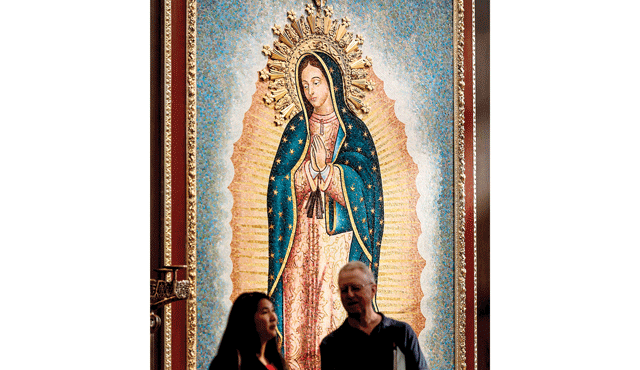As the calendar flips into early December, the thoughts of many in the local Catholic community turn toward the mysterious and ubiquitous image of Our Lady of Guadalupe, or the Virgin Mary as she appeared to a peasant in Mexico in 1531.
Now, that image of the Patroness of the Diocese of Orange, whose feast day is December 12, is literally front and center in a commissioned shrine at Christ Cathedral.
“The mosaic of Our Lady of Guadalupe in Christ Cathedral is located in a prominent place and can be seen from every angle of the Cathedral except for the south balcony,” said Father Christopher Smith, rector and episcopal vicar of Christ Cathedral. “The mosaic’s location has Mary looking upon the congregation as they worship, both as the first among the disciples and as our Blessed Mother.”
Deacon Guillermo Torres, director of Hispanic Ministry at the diocese, said the entrance of Christ Cathedral is a long linear expanse and “Our Lady breaks it up and really stands out.”
The 10-by-7-foot mosaic was commissioned in September, 2018 and created by the internationally renowned studio of Lenarduzzi Valerio Mosaics.
The Italian artist said in an email that the mosaic, one of about 30 his studio has created in Southern California, took about nine months to complete with three mosaic artists and another for the decorative frame. It was completed and installed just in time for the July 2019 grand opening and dedication of the cathedral.
The artwork features more than 55,000 tiles of gold and opaque glass. It also includes a 22-by-20-inch crown, made of gold leaf that will adorn Our Lady’s head for devotionals and on feast days.
“This Our Lady of Guadalupe is a special piece considering the beautiful decorative frame and the Crown, all 100 percent handmade,” according to Valerio.
The Christ Cathedral mosaic is about double the size of most similar works in Southland churches, according to parishioner William Close, who funded the installation.
Reproductions of holy and popular art works and original pieces by Atelier Lenarduzzi Mosaic grace churches, museums and buildings from Tokyo to Amsterdam to the Archdiocese of Los Angeles and the Vatican. The coats of arms mosaics in the narthex, or entrance area opposite the church’s main altar, were also by the studio.
This year, the Diocese of Orange’s mass for the feast of Our Lady of Guadalupe is at Christ Cathedral for the first time at 7 p.m., Thursday, Dec. 12. There will also be celebrations at parishes across the diocese to recognize the Virgin.
However, the importance of the appearances of the Virgin Mother to Cuauhtlatoatzin native Juan Diego in Mexico, runs far deeper than feasts and masses. It is hard to understate her importance in the local Catholic congregation. She is one of the diocese’s two patron saints, along with Saint Andrew Dũng-Lạc, a martyred Vietnamese Catholic priest, that represent the diversity of the congregation.
At the time of the Virgin Mother’s appearance, the Spaniards were already occupiers of Mexico and maintained an uneasy relationship with the native population. In 1895, Pope Leo XIII crowned her with a canonical coronation and Pope Pius II named her “Patroness of the Americas” in 1946, a title that was reiterated by Pope John Paul II in 1999. When the Diocese of Orange was created in 1976, Our Lady of Guadalupe was named its patroness.
Each year, congregants across the Southland celebrate the days surrounding the December 12 feast day of Our Lady of Guadalupe with colorful processions and vigils, homemade shrines and religious observances and Masses.
The original cloak remains on display and in good condition at the basilica bearing her name in Mexico, considered the most important Catholic site in the Americas, and visited by millions each year.
“Mary became the bridge between the conquerors and the indigenous people,” Torres said. “I feel like she brought a new humanity and a ray of hope.”
Our Lady of Guadalupe appeared, not as in some European depictions, but rather in traditional clothing and with facial features like those of the local population.
“It reminded them of themselves, not a foreign (people,)” Torres said of the mysterious image of Our Lady that was revealed in the tilma, or garment, of the peasant Juan Diego.
“It would have been very different, if we didn’t have that door,” Torres said of the Virgin’s appearance.
From Mexico, the deep connections to the Virgin of Guadalupe moved north and grew.
“She was chosen as the Patroness of the Diocese of Orange as a link to the beginnings of the Catholic Church in California, which began with Fr. Junipero Serra and those who founded the California missions,” said Father Christopher Smith in a written correspondence.
And she is not just a symbol for the Latino population.
“Our gentle Lady of the Tepeyac, Mother of God, is also Mother of the indigenous peoples, Afro-Americans, immigrants and refugees, of the young deprived of opportunity, of the old, of those who suffer any kind of poverty or marginalization,” according to Torres. “The Good Mother, and patroness of our diocese, embraces the richness and cultural diversity of our believers in Orange.”
To Smith, the local art is magical and a wonder to behold.
“I had tears in my eyes the first time I saw the mosaic because it is so beautiful. The colors are vibrant and the detail gives the image great depth. The colors are even more vibrant when the natural light shines on it as it does in so many different ways through the course of a day in our beautiful cathedral,” he said. “It almost has a heavenly feel to it, especially as one thinks that Our
Lady of Guadalupe has been venerated over many centuries, giving solace and hope to those who seek her intercession.”

